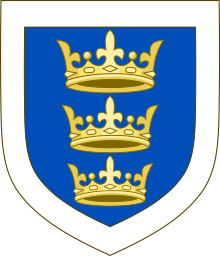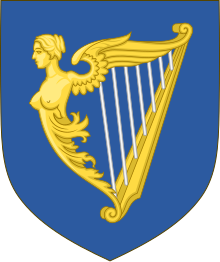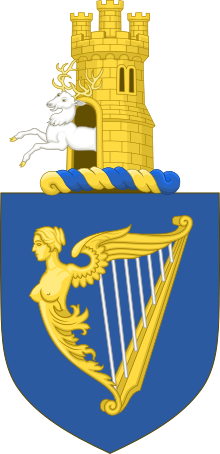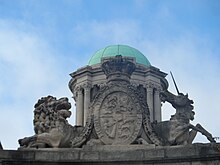Coat of arms of Ireland
| Coat of arms of Ireland | |
|---|---|
 | |
| Versions | |
 The banner of arms, which serves as presidential standard | |
royal coat of arms of the United Kingdom and is incorporated as a badge into devices used by official bodies in Northern Ireland . | |
The coat of arms of Ireland is
The depiction of the harp has changed over time. When the arms were restored as the arms of the independent Irish state in 1922, a late-medieval
Several variants of the arms of Ireland exist, including a
History

As
However, reference to the harp as the arms of the king of Ireland can be found in one of the oldest medieval
Whatever its origins, the harp was adopted as the symbol of the new
Today, the image of the harp is used on the
Presidential standard
As well as being the arms of Ireland, since 1945 the harp is the arms of each
Previous arms


The
It is believed that the three crowns were abandoned as the arms of Ireland after Henry VIII's split with
Despite this, the memory of the three crowns arms may have remained for a time with one
A variant of arms of the
Achievement



The design of the harp used by the modern Irish state is based on the Brian Boru harp, a late-medieval Gaelic harp now in Trinity College Dublin.[note 1] The design is by an English sculptor, Percy Metcalfe. Metcalfe's design was in response to a competition held by the state to design Irish coinage, which was to start circulation in December 1928. Metcalfe's design became the model for future official interpretations of the harp as an emblem of the state.[citation needed]
The modern design is markedly different from earlier depictions. During the 17th century, it became common to depict the harp with a woman's head and breasts, like a ship's figurehead, as the pillar.
It is not necessary to show a full complement of thirty strings, provided that the numbers do not fall below nine (notwithstanding the illustration to the left).[8] The strings are always silver and the harp is always gold.
The harp is shown on a blue background. The colour of the field is sometimes called
A crest, which was little used, is thought to have been created for the ascension of
Historically, the harp was frequently seen surmounted by a crown. In this case, the depiction is as
Supporters and motto

The arms of Ireland are without
Several mottos associated with Ireland and have also been used alongside representations of the harp, including the patriotic slogan,
Green flag
As well as the coat of arms, which shows the harp on an Azure (blue) field, Ireland has long been associated with a flag also bearing the harp. This flag is identical to the coat of arms but with a green field, rather than blue, and is blazoned Vert, a Harp Or, stringed Argent (a gold harp with silver strings on a green field).
The earliest-known record of the green flag is attributed to
Although the Kingdom of Ireland never had an official flag, this flag is recorded as the flag of Ireland by 18th- and 19th-century sources. It was used as a
Arms and Flag of the Four Provinces
The arms of the four traditional
The
The
Finally,
See also
- Armorial of Ireland
- Coat of arms of Northern Ireland
- Flag of Ireland
- Great Seal of the Irish Free State
- Irish heraldry
- List of flags of Ireland
- Seal of the president of Ireland
- Shamrock
Notes
- library of Trinity College Dublin
References
- ^ a b Genealogical Office (9 November 1945). "Grant of Arms (Registration): Arms of Ireland". Catalogue. National Library of Ireland. G.O. MS 111G; folio 20. Archived from the original on 18 May 2013.
- ^ "Heraldry in Ireland, 1943-2018". The National Library of Ireland. Archived from the original on 15 July 2020. Retrieved 4 March 2020.
- ^ a b Michael C. O'Laughlin, 2001, The Irish Book of Arms, Irish Genealogical Association, p 15
- ^ Hartemink, Ralf (1996). "Civic Heraldry of Ireland, National arms of Ireland". Heraldry of the World. ngw.nl. Archived from the original on 9 June 2011. Retrieved 13 July 2011.
- ^ Velde, François. "Heraldry in Ireland". Heraldica.
- ^ William Henry Grattan Flood, 1905, The Story of the Harp; James Simon, 1810, Simon's Essay on Irish coins, and of the currency of foreign monies in Ireland
- ^ a b c d e f g h Kennedy, John (Autumn 1991), "The Arms of Ireland: Medieval and Modern", Coat of Arms (155)
- ^ a b c d e Carragin, Eoin (18 April 2007). "Heraldry in Ireland". National Library of Ireland. p. 3. Archived from the original (PDF) on 27 September 2011. Retrieved 17 March 2008.
- ^ "Glossary". Irish Patents Office. pp. Article 6ter. Retrieved 31 May 2013.
- ^ "C.4304-551" (PDF). WIPO Circular (4304). 15 February 1985. Archived from the original (PDF) on 4 March 2016. Retrieved 31 May 2013.
Images: IE1 Archived 19 February 2013 at the Wayback Machine IE2 Archived 4 March 2016 at the Wayback Machine IE3 Archived 3 March 2016 at the Wayback Machine IE4 Archived 3 March 2016 at the Wayback Machine IE5 Archived 4 March 2016 at the Wayback Machine IE6 Archived 4 March 2016 at the Wayback Machine IE7 Archived 4 March 2016 at the Wayback Machine IE8 Archived 4 March 2016 at the Wayback Machine IE9 Archived 4 March 2016 at the Wayback Machine IE10 Archived 4 March 2016 at the Wayback Machine - ^ Humphreys, Joe (28 December 2013). "State feared Guinness objections over plan to make harp logo a trademark". The Irish Times. p. 1. Retrieved 29 December 2013.
- ^ W. G. Perrin and Herbert S. Vaughan, 1922, "British Flags. Their Early History and their Development at Sea; with an Account of the Origin of the Flag as a National Device", Cambridge University Press: Cambridge, pp. 51–52
- ^ a b Chambers's Encyclopædia: A Dictionary of Universal Knowledge, 1868, p. 627
- ^ Questions and Answers, Notes and Queries, 1855, p. 350
- ^ a b Fox-Davies, A.C., 1915, The Book of Public Arms, London
- ^ "17th Century Pictorial Map of Galway City". Archived from the original on 1 November 2018. Retrieved 13 November 2018.
- ISBN 978-1-4068-2770-5
External links
- Office of the Chief Herald of Ireland Archived 24 October 2014 at the Wayback Machine
